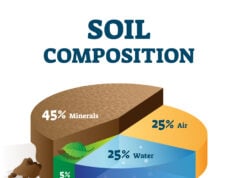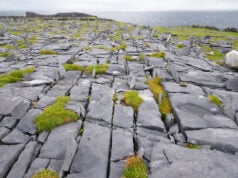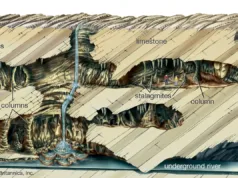Sediment transport and deposition are key processes in sedimentology that govern the formation of sedimentary rocks. The movement of sediment can occur through a variety of mechanisms, including wind, water, ice, and gravity. The nature of sediment transport is largely dependent on the energy of the transporting medium, which can range from gentle currents in a river to the violent flow of a pyroclastic flow from a volcanic eruption.
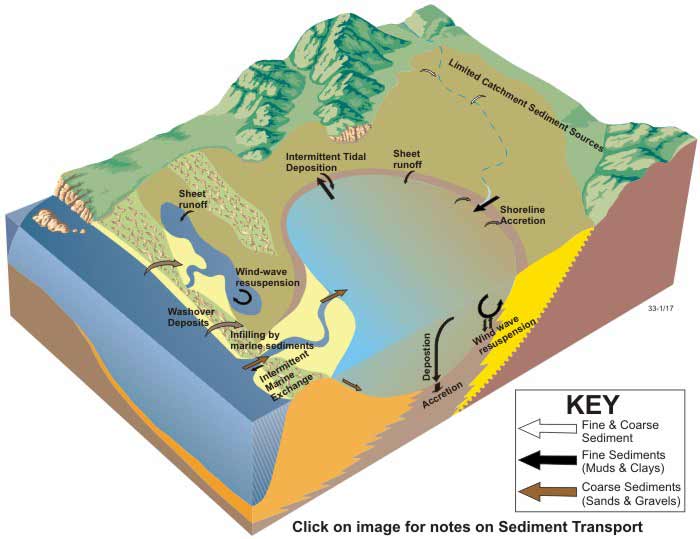
Once sediment is transported, it can be deposited in a wide range of environments, including river channels, lakes, deltas, beaches, and deep marine basins. The depositional environment influences the characteristics of the sediment that is deposited, such as grain size, sorting, and composition.
The study of sediment transport and deposition is critical for understanding the formation of sedimentary rocks and the environments in which they were deposited. This knowledge can also be applied to a range of practical applications, such as the management of water resources, the construction of dams and levees, and the prediction and mitigation of geological hazards such as landslides and debris flows.
Agents of Sediment Transport
The agents of sediment transport are the natural forces that move sediments from one location to another. These agents can be classified into several categories:
- Water: Sediment can be transported by rivers, streams, ocean currents, and waves. The amount of sediment transported by water depends on the velocity and turbulence of the water, the size and shape of the sediment particles, and the availability of sediment.
- Wind: Sediment can be transported by wind, especially in arid regions where there is little vegetation to hold the soil in place. Wind can move both fine-grained and coarse-grained sediment, and the amount of sediment transported depends on the wind speed and the size of the sediment particles.
- Ice: Sediment can be transported by glaciers, which move slowly downhill under their own weight. Glaciers can transport large amounts of sediment, including boulders, cobbles, and sand.
- Gravity: Sediment can be transported by gravity, especially on steep slopes and in mountainous regions. Gravity can cause landslides, rockfalls, and debris flows that transport sediment downslope.
- Biological agents: Sediment can also be transported by living organisms, such as burrowing animals, root systems of plants, and microbes.
The type and amount of sediment transported by each agent depends on a variety of factors, including the strength and duration of the agent, the type and size of the sediment, and the characteristics of the terrain.
Modes of Sediment Transport
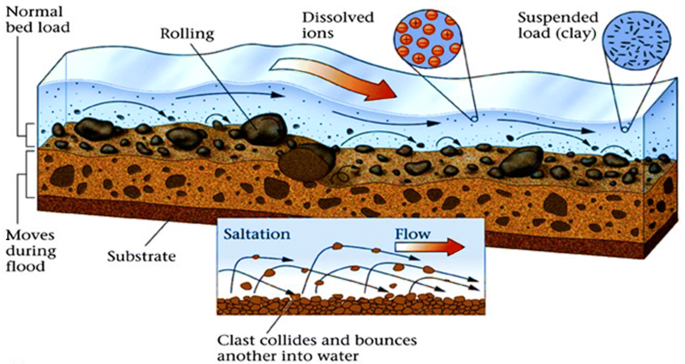
There are several modes of sediment transport, including:
- Bedload transport: This is the movement of sediment particles along the bottom of a river, stream, or ocean by rolling, sliding, or bouncing.
- Suspended load transport: This is the movement of small sediment particles that are suspended in the water column by the force of the flowing water.
- Saltation: This is a type of bedload transport in which sediment particles bounce along the bottom in a series of short hops.
- Traction: This is a type of bedload transport in which sediment particles are rolled or dragged along the bottom by the force of the flowing water.
The mode of sediment transport is influenced by a number of factors, including the velocity of the water, the size and shape of the sediment particles, and the density of the particles.
Bedload transport
Bedload transport is a process by which sediment particles on the bed of a river or stream are moved by the flow of water. In this process, larger sediment particles, such as gravel and sand, are picked up by the force of the water and roll, slide, or bounce along the bottom of the stream channel. Bedload transport is typically characterized by intermittent, high-energy flows that occur during periods of increased stream discharge, such as during storms or snowmelt events. The rate of bedload transport is influenced by a number of factors, including the size and shape of the sediment particles, the velocity of the water, and the slope and roughness of the stream channel. Bedload transport can have a significant impact on the physical and ecological characteristics of river and stream ecosystems, including the formation of riffles and pools, erosion of stream banks, and alteration of aquatic habitat.
Suspended load transport
Suspended load transport is one of the modes of sediment transport in which fine-grained particles, such as silt and clay, are carried in suspension by the moving fluid, typically water or air. The particles are suspended due to the upward components of turbulent eddies, which are generated by the fluid flow.
Suspended load transport can occur in a variety of environments, such as rivers, estuaries, oceans, and the atmosphere. The suspended load is generally considered to be the most significant component of sediment transport in rivers, and it can contribute to the formation of sedimentary deposits, such as floodplains and deltas, as well as to erosion and sedimentation downstream.
The amount of sediment that can be transported in suspension depends on a number of factors, including the velocity and turbulence of the fluid, the size and density of the particles, and the concentration of the sediment in the fluid. In general, the higher the velocity and turbulence of the fluid, the larger the particles that can be suspended, and the higher the concentration of sediment that can be transported.
Saltation
Saltation is a type of sediment transport in which particles, usually sand-sized, are bounced along a streambed or the surface of a dune by the flow of air or water. During saltation, the particles are lifted up into the air and then fall back to the surface, bouncing or hopping along in a series of short leaps. This type of sediment transport is important in rivers, streams, and other waterways where sand and other small particles are moved along the bottom by flowing water. It is also important in deserts, where sand is transported by wind, and on the surface of Mars, where the thin atmosphere allows sand to be transported by the wind in a similar manner.
Traction
Traction is a mode of sediment transport in which particles are rolled or slid along the bottom of a body of water or other fluid. Traction is often associated with coarser sediment particles, such as sand or gravel, that are too heavy to be transported in suspension or saltation. As water or another fluid moves over the particles, they are dragged along the bottom by the force of the moving fluid. The amount of sediment transported by traction depends on the strength of the current or flow, the size and shape of the sediment particles, and the characteristics of the sediment bed, such as the slope and roughness of the surface. Traction is an important process in shaping the morphology of rivers, streams, and other bodies of water, as well as in the formation of sedimentary deposits.
Depositional Environments
Depositional environments are the locations and conditions where sediment accumulates and are determined by the physical, chemical, and biological processes at work. They are classified based on the characteristics of the sediment and the dominant processes that create the deposit. Some common depositional environments include:
- Alluvial: Deposits formed by flowing water in river channels, floodplains, and alluvial fans.
Alluvial refers to sedimentary materials, such as sand, gravel, clay, or silt, that are deposited by flowing water, such as a river, stream, or flood. The term “alluvial” is derived from the Latin word “alluvium”, which means “wash against”. Alluvial deposits can be found in river channels, floodplains, deltas, and alluvial fans, and are often rich in minerals and organic materials. They are commonly used for construction materials, as well as for mining precious metals and other resources.
- Deltaic: Accumulation of sediment at the mouth of a river as it enters a standing body of water, often forming branching patterns of channels and distributaries.
Deltaic deposition occurs at the mouths of rivers, where they enter standing bodies of water such as lakes, seas, or oceans. Deltas are formed by the accumulation of sediment that is carried by the river and deposited at its mouth, as the river’s velocity decreases due to the standing body of water. The sediment is typically fine-grained and includes clay, silt, and sand, which are deposited in layers. The exact characteristics of the deltaic deposit depend on the nature of the sediment being transported, as well as the conditions at the mouth of the river, such as the strength and direction of tidal currents. Deltaic deposits are typically very rich in organic matter, making them important sources of hydrocarbons.
- Coastal: Deposits formed along the coast by the action of waves, currents, and tides, including beaches, barrier islands, and lagoons.
Coastal depositional environments are characterized by the presence of marine or coastal processes, such as waves, tides, and currents, that influence sediment transport and deposition. These environments can include beaches, dunes, barrier islands, tidal flats, and estuaries.
Beaches are the most common coastal depositional environment, formed by wave action and characterized by sand-sized sediment. They may be classified according to their degree of exposure to wave energy, from high-energy dissipative beaches to low-energy reflective beaches. Dunes can form behind beaches and are shaped by wind action. They can be important habitats for plants and animals, and also serve as a natural buffer against coastal erosion.
Barrier islands are long, narrow offshore landforms that parallel the coast and are separated from it by a lagoon or estuary. They are formed by the accumulation of sediment by wave and current action and can migrate over time in response to changes in sea level or sediment supply.
Tidal flats are low-lying coastal areas that are exposed at low tide and submerged at high tide. They are characterized by fine-grained sediment and can be important feeding and breeding grounds for marine animals. Estuaries are partially enclosed coastal bodies of water that are connected to the sea and are influenced by both marine and freshwater processes. They can be important nursery habitats for fish and other aquatic organisms, as well as important areas for shipping and recreation.
- Marine: Deposits formed in the ocean by currents, waves, and other processes, including continental shelves, slopes, and deep-sea basins.
Marine depositional environments are those in which sedimentation occurs in the ocean or sea. These environments are characterized by the presence of marine organisms and can range from shallow water to deep sea environments. Examples of marine depositional environments include:
- Continental Shelf: This is a shallow, gently sloping area of the ocean floor that extends from the shoreline to the shelf break, where the slope steepens. Sediments here are typically fine-grained, including sand, mud, and silt.
- Continental Slope and Rise: Beyond the continental shelf lies the continental slope, which is a steeply sloping area that extends down to the deep ocean floor. Sediments here are transported downslope by gravity and can include turbidites, which are deposits of sand and mud that result from underwater avalanches.
- Abyssal Plain: This is a flat, featureless area of the deep ocean floor that lies beyond the continental rise. Sediments here are typically very fine-grained and can include clay and silt.
- Mid-Ocean Ridge: This is an underwater mountain range that runs through the middle of the world’s oceans. Sediments here are typically volcanic in origin and can include pillow lavas and basalt.
- Hydrothermal Vents: These are deep sea environments where hot, mineral-rich water is discharged from the seafloor. Sediments here can include metal sulfides and other minerals.
- Coral Reefs: These are areas of shallow, warm water where coral animals build reefs. Sediments here can include sand and shell fragments, as well as coral debris.
- Estuaries: These are semi-enclosed coastal environments where freshwater and saltwater mix. Sediments here are typically fine-grained and can include sand, mud, and silt.
- Mangrove Swamps: These are coastal environments where mangrove trees grow in shallow water. Sediments here can include mud and organic debris.
- Glacial: Deposits formed by glaciers, including moraines, till, and glacial outwash plains.
Glacial deposition is a term used to describe the process by which glaciers erode and transport sediment and deposit it elsewhere as the ice melts. Glaciers erode rocks and other materials as they move, carrying the debris along with them. This material can range from large boulders to fine silt, depending on the size and strength of the glacier.
Glacial sediments are typically sorted into two categories: till and stratified drift. Till is the unsorted sediment deposited directly by the glacier as it melts, while stratified drift is sediment that has been sorted and deposited by meltwater streams flowing out of the glacier.
Glacial sediments can be found in a variety of environments, including mountain valleys, coastal regions, and continental interiors. These deposits are important indicators of past glacial activity and can provide valuable insights into the climate and landscape of the past. They also have economic importance, as glacial deposits often contain valuable minerals such as gold, silver, and copper.
- Aeolian: Deposits formed by wind, including sand dunes and loess.
Aeolian deposition refers to the transport and deposition of sediment by wind. Aeolian sediment is often characterized by its small size and well-sorted nature, as the wind tends to sort sediment grains by size and transport only the finest particles over long distances. Aeolian sediment is often deposited in dunes, which can take on a variety of shapes depending on wind direction and strength. The study of aeolian sediment and landforms is important in understanding past and present climates, as well as in the exploration and exploitation of natural resources such as oil and gas.
- Lacustrine: Deposits formed in lakes, including deltas, and deep lake basins.
Lacustrine environments refer to areas that are related to or are associated with lakes. These environments are characterized by the deposition of sediments in lakes, which may be later buried and preserved as sedimentary rocks. The depositional processes in lacustrine environments are determined by the size and shape of the lake basin, the depth of the lake, the surrounding climate, and the amount and type of sediment input from rivers or other sources.
Lacustrine environments can vary widely in their depositional characteristics and can be influenced by a number of factors. The type of sediment deposited in a lacustrine environment can range from fine-grained silt and clay to coarser-grained sand and gravel. The depositional environment can also vary from shallow-water to deep-water, and the sedimentary structures can range from thin layers of laminated silt and clay to thick-bedded sandstone and conglomerate.
Some of the common sedimentary features associated with lacustrine environments include rhythmites (repetitive layering of sediments), varves (thin laminations of sediment), and mud cracks. Fossils found in lacustrine sedimentary rocks can provide important information about the evolution of life in freshwater ecosystems, including fish, insects, and plant life. Additionally, lacustrine sedimentary rocks can also provide valuable information about past climate conditions, including fluctuations in temperature and precipitation, and volcanic or tectonic activity.
Each of these environments has unique characteristics, such as the types of sediment, sedimentary structures, and fossils present, and can provide important information about the geological and environmental history of an area. Sedimentary rocks formed in these different environments are used as indicators for past climates, sea level changes, tectonic activity, and evolution of life on Earth.


























